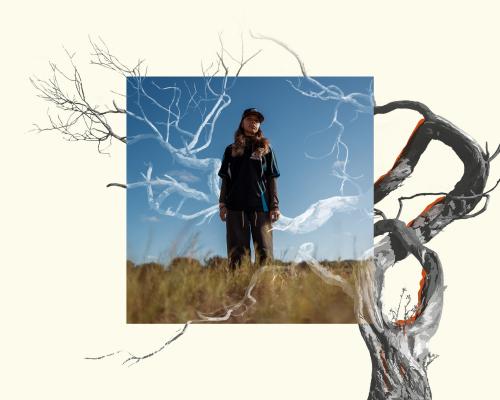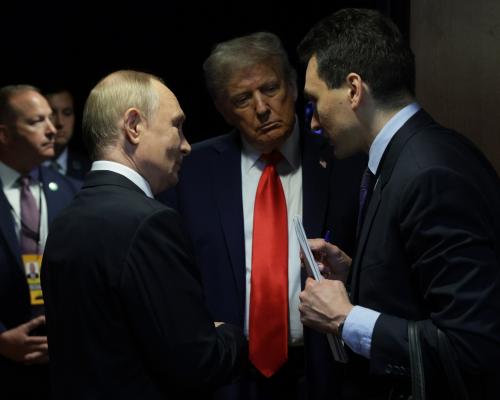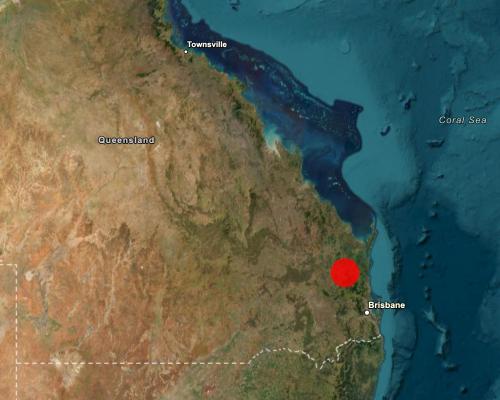
Warning: This article contains historical records that use racist and offensive language, and descriptions of events that will be distressing to some readers. It also contains references to Indigenous Australians who have died
The trees have a voice here. A gentle whispering of the needle-like pins of the casuarina pines as they rustle in the winds. Some say if you walk by the banks of the Greenough River you might see the eyes of spirits glowing among the dense trees and shrubs.
We’re on Naaguja country, about a 30-minute drive south from Geraldton, a coastal city in Western Australia. This spot is known by the traditional owners as Bootenal (pelican) Springs – and the namesake birds glide across the languid surface of the river.
Despite the idyllic surroundings, no one wants to be here when the fading light turns black.
A Naaguja man, Derek Councillor, speaks softly behind a thick grey beard. He drives along a bumpy dirt track, towards a closed-off field, his white Toyota four-wheel drive stained with the red dust of the surrounding hills. His granddaughter Kehlani sits in the front seat, her long brown hair underneath the borrowed wide brim of his Akubra hat.
At the going down of the sun, Derek says, the wails of the children can be heard, followed by the cries of women and finally the men. “It’s scary at night-time,” he says. The farmers whose homes dot the surrounding hills, descendants of settlers to this region, have also heard the spirits and the dead, he says.
“They’ll see a big fire burning, then they’ll come down to have a look,” Derek says. “Then they’ll get here and there’s no fire. They go back to their block, and then they’ll hear people singing and dancing, and then they’ll come and check it out again. There’s nobody there.” The Toyota bumps along, into the dusk.
Bootenal Springs is a massacre site. One hundred and seventy years ago the river turned red with blood. The Naaguja people say their ancestors await their blood to be answered.
“This is what we know,” says Derek’s cousin Theona Councillor. Her light brown eyes are warm, her voice calm but measured, each word carefully chosen. “This is our story, and we will tell it.”
A ‘bad place’
The Councillors have heard the story since their childhood, passed down by Derek’s father. The knowledge was imparted with a shift of the eyes and a solemn warning about Bootenal as a “bad place” before, when Derek was a teenager, his father gradually expanded the story of bloodshed.
In the early 1850s European settlers hungry for land had begun to stretch out from the port cities of Perth and Fremantle, encroaching on the territories of neighbouring tribes. They brought their families, cattle, crops and fences.
Sign up: AU Breaking News email
They were taking up tens of thousands of hectares, clearing land, planting potatoes“All of a sudden, our people couldn’t go there, they’d jump the fences … Sheep would go missing,” Derek says.
Aboriginal people also began to go missing.
The killings were sporadic at first. Settlers were angry with Naaguja for taking their livestock. The Naaguja, in turn, made threats against the settlers for encroaching on their lands.
In the winter of 1854 John Nicol Drummond led a campaign against the Naaguja people. A self-appointed inspector of police, the botanist had learned local languages including Noongar and relied on intel he had gleaned to launch the attack.
He gathered landowners, station hands and farmers to attack Naaguja families camped on the banks of the Greenough River.
The story from Uncle Harold Councillor is that the settlers came over the hills from east to west at dawn, shooting as they went. The sun coming up behind them blinded the family groups who were camped staying there.
The death toll is disputed. Officially, the settlers recorded that 30 men, women and children were killed. But the Councillors believe the toll was much higher. “Someone dropped a zero – it was at least 100,” Derek says.
‘Calls of their blood must be answered’
Theona has brought her daughter, grandchildren and cousins with her to Bootenal Springs on a bright warm day. They pick through the brush and scrub, avoiding the tangled roots and grasses.
They are not alone. The Councillors and other Naaguja elders are meeting with the ancestors of the perpetrators – families descended from the founding settlers of the town.
Theona has told Guardian Australia she will speak the truth. “This is what we know,” she says. “This is our story, and we will tell it and they are to listen. The calls of their blood must be answered.”
Now, on the riverbank, she introduces her cousins Avriel Maher, Edna Corbett and Peta Watkins to the white families they have travelled to meet.
“Margaret [is a] Criddle – her ancestor was one of the ones who rode in on the horses – and Amanda is the Drummonds,” Theona explains. “They’re coming for their side of the shield and we’re coming for our side.”
Margaret Jones, born Criddle, and Amanda Rowland, born Drummond, are nervous. Amanda has driven here from her home in Cervantes, about 200km up the coast.
This is not their first meeting with Theona and Derek, with the families having attended the 170th commemorations of the massacre last year. A circle of sand to mark the ceremonial dance is still there from that meeting, yet to be blown away by the winds. Plaques honouring the place and its history can be seen glinting in the sun. They are interpretative commemorations, created by the pioneers and the elders.
Jones tells of the chill she felt arriving then, the sickness she felt in her stomach when standing by the casuarina she-oaks before the realisation hit: it was a killing ground.
This was once a traditional camping site, abundant with bush foods. Families would spend nights clustered under the whispering trees, sheltering in a safe place to rest and hear Dreaming stories. The Bimarra Dreaming snake, a major creation spirit, once slithered its way through here.
Derek gathers everyone in a clearing, under a large casuarina. Theona’s daughter and grandchildren listen attentively, nodding as the story unfolds.
On the morning of the massacre, as the sun rose, the warriors were out hunting so it was mostly women, children and elders at the riverbank. “All the people were massacred in this spot here,” Derek says. “There was no mercy for anyone, all the women and children were killed that day.”
He adds: “We don’t tell it with hate, we remember our past but don’t dwell on it.”
But he points out that someone has gouged out selected words on one of the plaques. “Our people”, “our land” and “women and children were killed” have been struck through. Just days after we visited, more of the memorial was vandalised. Police are investigating.
‘I don’t want to lose that unsettledness’
There’s a saying in Geraldton: shake a tree and out pops a Criddle. The family has been in the region since the 1850s. But now those descendants are reckoning aloud with what the trees once whispered.
Margaret Jones – “Auntie Marg” to Theona – is warm and quick with a hug. She’s quick to tears too. Her family’s involvement in the massacre was hidden over time.
On the drive to the site, she says confronting that history has not been easy. “I’m a bit nervous, I have to say,” she says. “There’s still a whole raft of emotions.
“I don’t want to lose that unsettledness in me – because if I get to a place where it becomes commonplace, then I will lose the part that my family members played here.”
The group has come together thanks to Margaret’s cousin, George Criddle, who cracked open the family history books during PhD research.
George began writing letters to their fifth-great-grandmother after being inspired by the Gumbaynggirr academic and historian Dr Gary Foley to “look in the mirror”.
“I didn’t want to know this about my family, and I didn’t want to have that knowledge as a reflection on who I am and who my family is,” George says.
It was something that their father didn’t want to discuss, George says, and relations became strained. “That silence, that colonial silence, was just so obvious and so thick,” they say.
They feared that opening up with their family about what they knew would lead to exile, anger or rejection: “That whole period, I was worried that I’d be kicked out.”
Instead, it launched a period of greater understanding.
Confronting that uncomfortable and contested history began a reckoning in not just the Criddle family but the wider community. Derek led a cultural tour.
“It was really profound for my family,” Criddle says. “It was very difficult for everyone but it was also a release, because finally we’ve got the true history, or we’ve got connection to a history that had been silenced.”
It’s a reckoning that has been years in the making.
‘I dropped six generations of shit’
We meet local historians and other curious community members at the Greenough Museum in Geraldton.
Artefacts of colonisation are all around us. A gleaming wagon wheel and embroidered tapestries on the walls provide a thin veneer of genteel pioneering history, a backdrop to our circle of plastic garden chairs. Dusty enamelled canisters line the kitchen benches and heavy jarrah floors support a table long enough to seat a platoon.
Amanda says that as a child she took pride in belonging to a “foundational family”.
“I grew up feeling I was very, very special,” she says. “Information started to filter through as a teenager, when I realised it wasn’t all fabulous, brave pioneer stuff.”
The commemorations of the 170th anniversary, and her subsequent work with Theona exploring the history through art, has allowed her to acknowledge that legacy and the benefits conferred upon her family for their role in frontier violence.
“There was a war [that] my family did really well out of,” she says. “Here was an Aboriginal person and Naaguja people, inviting me to really look at this. It is just really profound for me.
“I dropped six generations of shit, basically. The land, the people, something spoke through me.”
She remains shaken by what she learned and is still learning.
“I didn’t know that women and children were killed,” she says.
Each time she visits the site, Drummond says, she is horrified anew. “You think you have heard it all and then,” she pauses. The wind also pauses, and the she-oaks stop talking.
“I don’t know how I feel really, there’s always something to tip you over. But I thank the Councillors.”
Theona understands being unmoored by history and its losses.
“They’re losing their comfortable untruth – where it feels good and safe but it’s actually not the truth,” she says. “I think they need to release themself. They need to actively seek it, release it. We can’t do it for them. They have to do it.”
Derek says the stories must keep being told. “We want to remember them today and that’s why we still tell their story,” he says. “We don’t let them fade off and disappear in history.”
• Indigenous Australians can call 13YARN on 13 92 76 for information and crisis support; or call Lifeline on 13 11 14, Mensline on 1300 789 978 or Beyond Blue on 1300 22 4636
• Lorena Allam is a professor at the Jumbunna Institute for Indigenous research at the University of Technology Sydney





